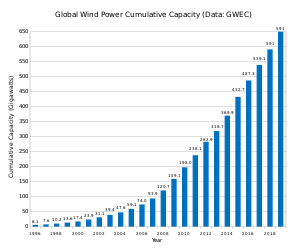Talk:United States wind energy policy/Archive 1
| This is an archive of past discussions about United States wind energy policy. Do not edit the contents of this page. If you wish to start a new discussion or revive an old one, please do so on the current talk page. |
| Archive 1 |
Competitive Renewable Energy Zones
Some states are responding to the issue of access to adequate transmission facilities though competitive renewable energy zones (CREZs) which, "attempt to optimize the linking of promising wind zones with demand centers and overcome the “chicken and egg” problem between wind plant developers and transmission providers. California is pursuing a similar CREZ policy, and other states, including New Mexico, Wyoming, and Colorado, are expanding transmission infrastructure to accommodate wind and other electricity options." CRS Report for Congress --Maddenwg (talk) 02:16, 24 March 2011 (UTC)
Related Wiki Article
The wiki page on Chapter 100: Wind Energy Systems (see Title 42 of the United States Code) has not been written yet. This could a possible outlet for our project... --Maddenwg (talk) 15:40, 24 March 2011 (UTC)
Nice progress!
Hey there! You're progressing very nicely on your sandbox. You seem to have gotten the hang of references, and your prose style is quite encyclopedic. Keep it up! ManishEarthTalk • Stalk 08:49, 25 March 2011 (UTC)
- And good job moving the article! Let me know when you want to nominate for DYK, or if you need any help at all! ManishEarthTalk • Stalk 03:40, 19 April 2011 (UTC)
General Policy Issues
I'm moving this section here for discussion:
The wind energy industry faces many barriers that impede market entry. These barriers continue to shape both federal and state policies as society's desire for clean and renewable energy grows. Despite often being labeled as a clean source for electricity, environmental impacts top the list as some of the greatest concerns associated with wind turbines. Despite these issues, societal concerns about energy independence & security of the United States, as well as environmental effects that lead to climate change have led to public polity that promotes electricity production from wind.[1]

Unfortunately, there are several problems here. Firstly, it seems that most of what is said in this paragraph is not actually verified in the source given, which is not surprising since some highly contentious statements are being made. If "the wind energy industry faces many barriers that impede market entry" why is the wind industry and wind power capacity growing so quickly in the US? You can see the worldwide growth in graphical form to the right and the US has played a large role in supporting this upward trend. This is discussed in Wind power in the United States.
Secondly, another contentious statement is "environmental impacts top the list as some of the greatest concerns associated with wind turbines"? What source says this? In contrast, this is more like the sort of thing I read about environmental impacts:
A modern wind farm, when installed on agricultural land, has one of the lowest environmental impacts of all energy sources: [1]
- It occupies less land area per kilowatt-hour (kWh) of electricity generated than any other renewable energy conversion system, and is compatible with grazing and crops.
- It generates the energy used in its construction within just months of operation.
- Greenhouse gas emissions and air pollution produced by its construction are small and declining. There are no emissions or pollution produced by its operation.
- Modern wind turbines rotate so slowly (in terms of revolutions per minute) that they are rarely a hazard to birds.[2]
Landscape and heritage issues may be a significant issue for certain wind farms. However, when appropriate planning procedures are followed, the heritage and landscape risks should be minimal. Some people may still object to wind farms, perhaps on the grounds of aesthetics, but their concerns should be weighed against the need to address the threats posed by climate change and the opinions of the broader community. p. ix
The third issue concerns negative language. Repeated use of words such as "barriers" and "concerns", without any use of words like "growth" and "benefits", leave the reader with a negative impression of wind power, and so the paragraph is unbalanced and POV.
All in all, the paragraph is simplistic, biased against wind power, and has significant POV problems. It has no place in the article. Johnfos (talk) 01:10, 16 May 2011 (UTC)
References
- ^ "Wind Energy Systems Act of 1980, 42 U.S.C. §9201 (2009)". Retrieved 18 April 2011.
- ^ "GWEC, Global Wind Report Annual Market Update". Gwec.net. Retrieved 2011-05-14.
